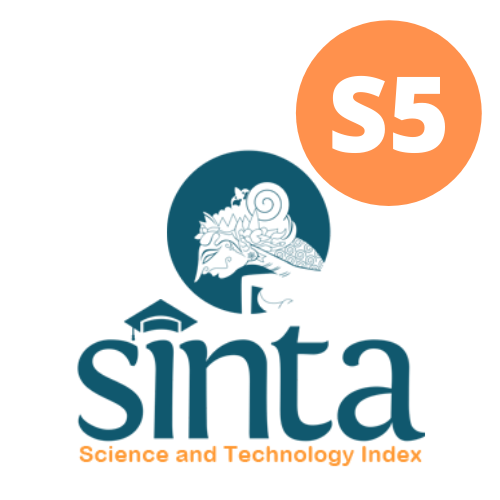RISK OF POST STROKE PNEUMONIA DURING HOSPITALIZATION
DOI:
https://doi.org/10.47522/jmk.v1iIAHSC.119Keywords:
A2DS2, Pneumonia, Non-Hemorrhagic StrokeAbstract
Introduction: Post-stroke pneumonia is the most a common complication during the first few weeks after a stroke. Thus, a score is needed for the early identification of stroke patients with an increased risk of pneumonia to assist the nursing team in preventing the onset of pneumonia in stroke patients during hospitalization. This study aimed to assess the application of the A2DS2 score to predict pneumonia in acute ischemic stroke patients.
Method: This is a diagnostic study that used a cross-sectional method conducted among adult acute ischemic stroke patients. Data analysis was performed to assess the calibration and discrimination performance of the A2DS2 score.
Results: A total of 16 respondents were followed up. The incidence of post-stroke pneumonia was observed in 6 patients (37.5%).
Conclusion: This scoring proved clinically accurate to predict the incidence of pneumonia in acute ischemic stroke patients.
References
Almeida, S. R., Bahia, M. M., Lima, F. O., Paschoal, I. A., Cardoso, T. A., & Li, L. M. (2015). Predictors of pneumonia in acute stroke in patients in an emergency unit. Arq Neuropsiquiatr, 73(5), 415-419. https://doi.org/10.1590/0004-282x20150046
Anindhita, T., & Wiratman, W. (2017). Buku ajar neurologi. Departemen Neurologi FKUI-RSCM.
Gong, S., Zhou, Z., Zhou, M., Lei, Z., Guo, J., Chen, N., & He, L. (2016). Validation of risk scoring models for predicting stroke-associated pneumonia in patients with ischaemic stroke. Stroke Vasc Neurol, 1(3), 122-126. https://doi.org/10.1136/svn-2016-000025
Haast, R. A., Gustafson, D. R., & Kiliaan, A. J. (2012). Sex differences in stroke. J Cereb Blood Flow Metab, 32(12), 2100-2107. https://doi.org/10.1038/jcbfm.2012.141
Hannawi, Y., Hannawi, B., Rao, C. P., Suarez, J. I., & Bershad, E. M. (2013). Stroke-associated pneumonia: major advances and obstacles. Cerebrovasc Dis, 35(5), 430-443. https://doi.org/10.1159/000350199
Hassan, M., Tuckman Howard, P., Patrick Robert, H., Kountz David, S., & Kohn Jennifer, L. (2010). Hospital length of stay and probability of acquiring infection. International Journal of Pharmaceutical and Healthcare Marketing, 4(4), 324-338. https://doi.org/10.1108/17506121011095182
Hoffmann, S., Malzahn, U., Harms, H., Koennecke, H. C., Berger, K., Kalic, M., Walter, G., Meisel, A., & Heuschmann, P. U. (2012). Development of a clinical score (A2DS2) to predict pneumonia in acute ischemic stroke. Stroke, 43(10), 2617-2623. https://doi.org/10.1161/strokeaha.112.653055
Ji, R., Shen, H., Pan, Y., Wang, P., Liu, G., Wang, Y., Li, H., & Wang, Y. (2013). Novel risk score to predict pneumonia after acute ischemic stroke. Stroke, 44(5), 1303-1309. https://doi.org/10.1161/strokeaha.111.000598
Kemenkes-RI. (2013). Riset kesehatan dasar 2013. http://www.depkes.go.id
Kulnik, S. T., Birring, S. S., Moxham, J., Rafferty, G. F., & Kalra, L. (2015). Does respiratory muscle training improve cough flow in acute stroke? Pilot randomized controlled trial. Stroke, 46(2), 447-453. https://doi.org/10.1161/strokeaha.114.007110
Kulnik, S. T., Rafferty, G. F., Birring, S. S., Moxham, J., & Kalra, L. (2014). A pilot study of respiratory muscle training to improve cough effectiveness and reduce the incidence of pneumonia in acute stroke: study protocol for a randomized controlled trial. Trials, 15, 123. https://doi.org/10.1186/1745-6215-15-123
Li, L., Zhang, L.-H., Xu, W.-P., & Hu, J.-M. (2014). Risk assessment of ischemic stroke associated pneumonia. World journal of emergency medicine, 5(3), 209-213. https://doi.org/10.5847/wjem.j.issn.1920-8642.2014.03.009
Li, Y., Song, B., Fang, H., Gao, Y., Zhao, L., & Xu, Y. (2014). External validation of the A2DS2 score to predict stroke-associated pneumonia in a Chinese population: a prospective cohort study. PLoS One, 9(10), e109665. https://doi.org/10.1371/journal.pone.0109665
Liu, D. D., Chu, S. F., Chen, C., Yang, P. F., Chen, N. H., & He, X. (2018). Research progress in stroke-induced immunodepression syndrome (SIDS) and stroke-associated pneumonia (SAP). Neurochem Int, 114, 42-54. https://doi.org/10.1016/j.neuint.2018.01.002
Lori, A. (2011). Ischaemic Stroke. CME Resource.
Muela, H. C., Costa-Hong, V. A., Yassuda, M. S., Moraes, N. C., Memória, C. M., Machado, M. F., Macedo, T. A., Shu, E. B., Massaro, A. R., Nitrini, R., Mansur, A. J., & Bortolotto, L. A. (2017). Hypertension Severity Is Associated With Impaired Cognitive Performance. J Am Heart Assoc, 6(1). https://doi.org/10.1161/jaha.116.004579
O'Donnell, M. J., Xavier, D., Liu, L., Zhang, H., Chin, S. L., Rao-Melacini, P., Rangarajan, S., Islam, S., Pais, P., McQueen, M. J., Mondo, C., Damasceno, A., Lopez-Jaramillo, P., Hankey, G. J., Dans, A. L., Yusoff, K., Truelsen, T., Diener, H. C., Sacco, R. L., . . . Yusuf, S. (2010). Risk factors for ischaemic and intracerebral haemorrhagic stroke in 22 countries (the INTERSTROKE study): a case-control study. Lancet, 376(9735), 112-123. https://doi.org/10.1016/s0140-6736(10)60834-3
Palm, F., Urbanek, C., Wolf, J., Buggle, F., Kleemann, T., Hennerici, M. G., Inselmann, G., Hagar, M., Safer, A., Becher, H., & Grau, A. J. (2012). Etiology, risk factors and sex differences in ischemic stroke in the Ludwigshafen Stroke Study, a population-based stroke registry. Cerebrovasc Dis, 33(1), 69-75. https://doi.org/10.1159/000333417
Pássaro, L., Harbarth, S., & Landelle, C. (2016). Prevention of hospital-acquired pneumonia in non-ventilated adult patients: a narrative review. Antimicrobial Resistance & Infection Control, 5(1), 43. https://doi.org/10.1186/s13756-016-0150-3
Sutbeyaz, S. T., Koseoglu, F., Inan, L., & Coskun, O. (2010). Respiratory muscle training improves cardiopulmonary function and exercise tolerance in subjects with subacute stroke: a randomized controlled trial. Clin Rehabil, 24(3), 240-250. https://doi.org/10.1177/0269215509358932
Wang, K. W., Chen, H. J., Lu, K., Liliang, P. C., Huang, C. K., Tang, P. L., Tsai, Y. D., Wang, H. K., & Liang, C. L. (2013). Pneumonia in patients with severe head injury: incidence, risk factors, and outcomes. J Neurosurg, 118(2), 358-363. https://doi.org/10.3171/2012.10.Jns127
Wu, O., Cloonan, L., Mocking, S. J., Bouts, M. J., Copen, W. A., Cougo-Pinto, P. T., Fitzpatrick, K., Kanakis, A., Schaefer, P. W., Rosand, J., Furie, K. L., & Rost, N. S. (2015). Role of Acute Lesion Topography in Initial Ischemic Stroke Severity and Long-Term Functional Outcomes. Stroke, 46(9), 2438-2444. https://doi.org/10.1161/strokeaha.115.009643
Downloads
Published
How to Cite
Issue
Section
License
Copyright (c) 2021 Jurnal Mitra Kesehatan

This work is licensed under a Creative Commons Attribution-NonCommercial-ShareAlike 4.0 International License.
Jurnal Mitra Kesehatan memberikan akses terbuka terhadap siapapun agar informasi pada artikel ini dapat bermanfaat bagi orang banyak. Jurnal dapat diakses tanpa dipungut biaya, sesuai dengan lisensi creative commons yang digunakan.










